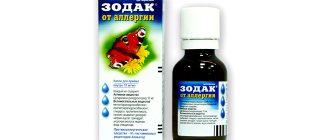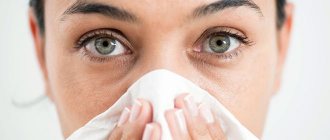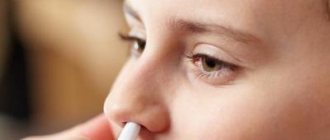Composition and release form
| Eye drops | 1 ml |
| active substance: | |
| azelastine hydrochloride | 0.5 mg |
| excipients: hydroxypropyl methylcellulose (hypromellose) - 10 mg; disodium edetate - 5 mg; benzalkonium chloride - 1.25 mg; sorbitol 70% - 666.66 mg; sodium hydroxide - up to pH 6; water for injection – up to 10 ml |
| Dosed nasal spray | 1 fl. |
| active substance: | |
| azelastine hydrochloride | 0.01 g |
| excipients: hypromellose - 0.01 g; disodium edetate dihydrate - 0.005 g; anhydrous citric acid - 0.00438 g; sodium hydrogen phosphate dodecahydrate - 0.0648 g; sodium chloride - 0.0687 g; purified water - up to 10 ml |
The active ingredient is azelastine (plus auxiliary components).
The main manufacturer of the drug is Meda Pharma (Germany).
Allergodil is a clear, colorless or almost colorless solution, available in the form of a nasal spray and eye drops:
- spray 140 mcg/10 mg – a 10 ml bottle (60 doses) is equipped with a spray dispenser;
- eye drops 0.05% – dropper bottle with a volume of 6 ml or 10 ml.
Properties of the drug
Allergodil contains such active substances as:
- methyl chlorophenyl;
- azelastine;
- hexahydro-methyl-azepine.
This drug is colorless. One dose of the medicine (0.14 milliliters) contains 0.14 milligrams of the active substance, which is called “azelastine hydrochloride”. In addition, this tool has additional elements:
- hypromellose is 0.01 grams;
- sodium chloride solution – 0.0687 grams;
- the amount of purified water is 10 milliliters;
- sodium hydrogen phosphate dodecahydrate – 0.0648 grams;
- amount of anhydride – 0.00438 g.
Allergodil drops and spray are considered an antiallergic agent.
Description and release forms
The main active ingredient of the drug is azelastine hydrochloride. The medication Allergodil is available in 2 forms:
- Nasal spray. The liquid is colorless, transparent. It is produced in dark glass bottles, 10 milliliters in volume, with a special spray nozzle.
- Transparent eye drops, 6 milliliters in volume, are sold together with a dropper and in a polyethylene bottle.
The spray eliminates the signs of allergic rhinitis within a quarter of an hour, and lasts up to 12 hours. The use of eye drops reduces itching, tearing and redness.
Indications for use
Allergodil is recommended for the treatment and prevention of seasonal and year-round rhinitis and rhinoconjunctivitis of an allergic nature. Can be used for vasomotor (non-allergic) rhinitis, since the symptoms of the diseases are similar.
There is also such a thing as drug-induced rhinitis, information about which you will find here.

Experimental studies have not revealed any negative effects of medications on health in young children and pregnant women. However, the following are considered contraindications for the spray:
- hypersensitivity to the components of the drug;
- for allergic rhinitis/rinoconjunctivitis - children up to 6 years of age (for spray), up to 4 years (for eye drops);
- 1st trimester of pregnancy and lactation period;
- renal failure;
- for vasomotor rhinitis - children under 12 years of age.
Find out about other drugs for the treatment of vasomotor rhinitis here.
The drug is used depending on the form of release:
- Allergic conjunctivitis, for preventive purposes and for therapy during seasonal exacerbations.
- Chronic conjunctivitis (long-term treatment).
- Rhinitis is chronic and seasonal.
- Hay fever, rhinoconjunctivitis - with long-term therapy.
- Vasomotor year-round non-allergic rhinitis (nasal congestion, rhinorrhea, sneezing).
The drug Allergodil is not recommended for patients with intolerance to the components included in the composition. It is also prohibited to use for the treatment of children under 6 years of age.
During drug therapy, patients should refrain from driving vehicles, as the medication may affect the reaction rate. It is recommended to discuss this issue with a specialist. Eye drops should not be used by children under 4 years of age.
Indications and contraindications for use
Azelastine is prescribed for allergic conjunctivitis and rhinitis, regardless of etiology. It is used to eliminate discomfort during seasonal hay fever and irritations that occur regardless of the season, including the idiopathic type. Eye drops are introduced into therapeutic regimens for the development of infectious pathologies of the visual organ as an adjuvant.
Contraindications for use:
- individual intolerance to the main active ingredient or additional ingredients;
- pregnancy;
- lactation;
- age up to 4 years for eye drops and up to 6 years for spray;
- injuries and damage to the mucous membrane, surgery on the eyes and nasopharynx.
Do not use the drug for frequent dizziness, pathologies of the cardiovascular system, the symptoms of which are circulatory disorders caused by vascular spasms. If you periodically experience headaches that are similar in nature to migraines, you should notify your doctor.
Read more Nasal drops Xylene - instructions
Danger of overdose
Eye drops, intraconjunctival.
Seasonal allergic conjunctivitis: unless otherwise recommended by a doctor, adults and children over 4 years old - 1 drop in each eye 2 times a day (morning and evening). If necessary, 1 drop in each eye up to 4 times a day.
In case of suspected exposure to an allergen, the drug is used for prophylactic purposes.
Non-seasonal (year-round) allergic conjunctivitis: in the absence of other doctor’s recommendations, adults and children under 12 years old - 1 drop in each eye 2 times a day (morning and evening). If necessary, 1 drop in each eye up to 4 times a day.
Dosed nasal spray, intranasal.
Allergic rhinitis and rhinoconjunctivitis: unless otherwise recommended, adults and children 6 years of age and older - 1 dose (140 mcg/0.14 ml) in each nasal passage 2 times a day (morning and evening). If necessary, adults and children over 12 years of age - 2 doses (280 mcg/0.28 ml) in each nasal passage 2 times a day (morning and evening).
Allergodil is used until symptoms stop and is suitable for long-term use, but not more than 6 months of continuous treatment.
Vasomotor rhinitis: adults and children over 12 years of age - 2 doses (280 mcg/0.28 ml) in each nasal passage 2 times a day (morning and evening).
Allergodil is used until symptoms stop and is suitable for long-term use, but not more than 8 weeks of continuous treatment.
Nasal spray:
- seasonal and year-round rhinitis/rinoconjunctivitis – 1 – 2 doses in each nasal passage 2 times a day. For mild forms of the disease, a single application is sufficient. Course – up to 6 months;
- vasomotor rhinitis - 2 doses in each nasal passage 2 times a day. The course should not exceed 8 weeks;
Eye drops:
- 1 drop in each eye 2 – 4 times a day. When using Allergodil simultaneously with other drops for allergic rhinitis, keep a 15-minute break between instillations.
There is no information about overdose.
special instructions
Azelastine does not have an antimicrobial effect, therefore, in case of secondary infection, the use of drops should be abandoned or the therapeutic regimen should be supplemented with antiviral, antibacterial or antifungal drugs. In some cases, treatment is stopped.
Since systematic instillations can provoke attacks of dizziness or short-term drowsiness, for 15 minutes after administration you should refrain from activities requiring increased attention, including driving a vehicle.
Interactions with drugs
If antiallergic eye drops are combined with any topical medications in the same form, it is advisable to use them last, after 5-10 minutes. When supplementing the therapeutic course with ointments, after Azelastine they are administered no earlier than 15 minutes later.
Read more Nasal drops Semax - instructions and analogues
When taken simultaneously:
- with respiratory analeptics - convulsions and breathing problems may occur;
- with Alprazolam - the sedative effect increases, the speed of psychomotor reactions decreases;
- with tranquilizers - their effect is enhanced.
Ketoconazole reduces the therapeutic effect of Azelastine. It is necessary to avoid medications containing ethyl alcohol. The active component of the drug cannot be combined with alcohol. The nasal spray contains a concentrate of benzalkonium chloride, which can cause irritation and provoke the development of allergic reactions.
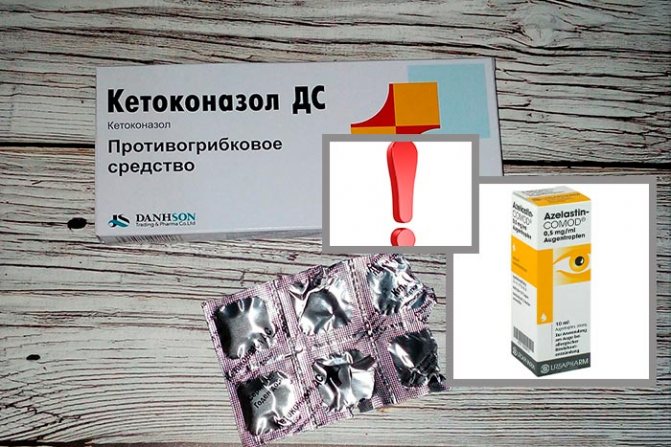
Contact lenses
Some ophthalmologists insist that during treatment you need to temporarily abandon contact lenses and wear glasses. If this is inconvenient for the patient, then before inserting medical accessories for individual vision correction, they must be removed, regardless of the material from which they are made. You can return it to its place no earlier than after 15-20 minutes.
Instructions for use
The instructions for use of the drug state that the medicine is used based on the form of release and the current disease:
- Allergic conjunctivitis caused by seasonal exacerbation - morning and evening, 1 drop in each eye. In severe cases of the disease, it is allowed to increase instillation to 4 times a day, but after consulting a therapist or pediatrician.
- Chronic allergic conjunctivitis - used in the same way as for seasonal conjunctivitis. Allowed to be used for prophylactic purposes.
- Spray - spray into each nostril. 1 dose in each nasal passage twice a day for adults and children over 6 years of age. After 12 years, the dosage is allowed to be doubled.
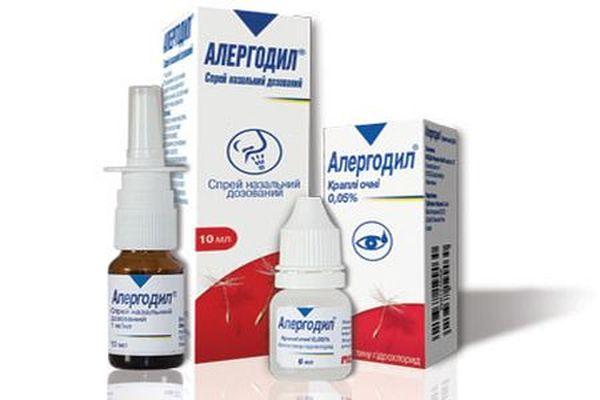
The spray is used for no more than 58 days.
The drug is intended for the treatment of:
- seasonal and persistent allergic rhinitis (including hay fever);
- seasonal and permanent rhinoconjunctivitis;
- symptoms of vasomotor rhinitis (nasal congestion, sneezing, rhinorrhea, postnasal drip).
Analogs
Like any medicinal composition, Allergodil has medications that are similar in composition and action. Let's look at the most famous analogues:
- Allergo-Komod - eye drops for allergies. It is forbidden to use in children under 4 years of age and in case of individual intolerance. For treatment, the drug is instilled 1 drop at an interval of 4-6 hours 4 times a day.
- Alomide. Eye drops. 1 to 2 drops in each eye four times daily. Contraindications – individual intolerance to the components.
- Cromoglin - nasal spray or eye drops. Antiallergenic agent. It is forbidden to use for children under 4 years of age and for adults with individual intolerance.
Allergodil is an antihistamine drug available in two forms. It is allowed to be used not only by adults, but also by children, since no cases of overdose have been observed.
In most cases, opinions about the medication are positive, which indicates its rapid action. Allergodil effectively eliminates inflammatory processes and is sold in all pharmacies.
You can buy Allergodil at any pharmacy without a doctor's prescription. Prices for nasal spray range from 255 to 900 rubles; for eye drops - from 380 to 830 rubles.
Analogues of the drug:
- Alomide - the effect does not occur immediately, discomfort and pain are possible;
- Zaditen (also available in the form of tablets and syrup);
- Opatanol – discomfort, burning, tearing;
- Reactin (spray) – there are side effects;
- Ifiril - the effect does not occur immediately;
- Tizin (spray);
- Histimet (spray) – myalgia, nausea, blurred vision.
For the treatment of rhinitis, doctors recommend using the drug Cromohexal, which is described in detail in this article.
Available in other dosage forms: eye drops.
Allergy sprays and nasal drops
Average price online*, 589 rub. (10 ml)
Effect of the drug
The drug has antihistamine, membrane-stabilizing, antihistamine properties. The action is universal, which allows it to be used in ophthalmological and otolaryngological practice. Instillations reduce capillary permeability and secretion, stop the production of histamine by H1 receptors, and prevent the development of inflammatory processes.
For allergic conjunctivitis, the drug not only relieves unpleasant symptoms, but also eliminates pain and hyperemia, and stops lacrimation. The use of drops helps to cope with irritation caused by overexertion and restores a healthy appearance to the eyes.
The action is prolonged. After instillation, the solution is quickly distributed over the cornea, a minimal amount is absorbed into the systemic circulation, but penetrates the blood-brain and placental barriers. Maximum effectiveness is 4-5 hours after administration, half-life is 12 hours. The active component is excreted in the form of metabolites, 92 percent through the urinary system, the rest through the respiratory system and secretory glands.
Side effects
When treated with medication, the development of negative reactions is possible:
- allergy – with intolerance to components, manifested in the form of itching, hives, rash;
- rapid breathing, cough, shortness of breath, bronchospasm;
- headache, dizziness, fatigue;
- gagging, decreased appetite, bitterness in the mouth, nausea, desire to drink a lot and often;
- weight gain, rapid heartbeat;
- increased dryness;
- burning sensation of the mucous membrane;
- in rare cases, nosebleeds are possible;
- lacrimation, dryness of the mucous membrane of the eyes;
- excessive swelling, blurred vision.
Side effects
The use of Allergodil eye drops may cause the following adverse reactions:
- swelling and redness;
- increased lacrimation;
- itching;
- irritation and soreness;
- bleeding in the eye;
- visual impairment;
- foreign body sensation;
- blepharitis;
- dry eyes.
Systemic manifestations of this form of the drug are extremely rare. The most common of these are difficulty defecating and difficulty breathing.
As for the nasal spray, it can cause the following undesirable effects:

- nose bleed;
- sneezing, burning and itching in the nose;
- skin itching and rash;
- weakness and dizziness;
- nausea due to entry into the nasopharynx (only when administering the drug with the head thrown back);
- gastralgia and dry mouth;
- tightness in the chest.
conclusions
- The drug Allergodil is a powerful allergy remedy with a long period of action.
- Quickly relieves painful symptoms.
- Side effects are minimal. It is also allowed to be used during pregnancy for allergic rhinitis, but you must consult a doctor.
- Long-term use without addiction is possible.
- Convenient release form (eye drops and nasal spray).
- Free sale in pharmacies and affordable price.
- Does not require additional treatment with oral medications.
Storage conditions for the drug Allergodil®
Sold in pharmacies without a specialist prescription. It is recommended to store at a temperature from 8 to 25 degrees. It is prohibited to freeze Allergodil.
At a temperature not exceeding 25 °C.
Keep out of the reach of children.
https://www.youtube.com/watch?v=gn27n9Mmvsc
eye drops 0.05% - 3 years. After opening the bottle, the drug should be used within 4 weeks.
dosed nasal spray 0.14 mg/dose - 3 years. After opening the bottle, the drug should be used within 6 months.
Do not use after the expiration date stated on the package.
Allergozol-DF 0.03% 10ml eye/nasal drops
Name
Alergozol-DF
Dosage form
Nasal drops 0.03% and 0.06%, 10.0 ml each
Nasal spray 0.03% and 0.06% 10.0 ml each
Compound
10.0 ml of the drug contains an adult dosage and a children's dosage active substances: naphthyzine diphenhydramine 6.0 mg 10.0 mg 3.0 mg 5.0 mg excipients: boric acid purified water 200.0 mg to 10.0 ml
Description
Transparent colorless or slightly colored liquid.
Pharmacological properties
Alergozol-DF has an antiallergic and vasoconstrictor effect due to the content of the alpha-adrenometic agent - naphthyzine, and the H1-histamine blocker - diphenhydramine. Naphthyzine is a sympathomimetic with a direct stimulating effect on alpha-2 adrenergic receptors. Due to the vasoconstrictor effect, swelling, hyperemia, and exudation are reduced. When used intranasally, naphthyzine helps to ease nasal breathing during rhinitis. Promotes the opening and expansion of the exit ducts of the paranasal sinuses and the release of the Eustachian tubes. This promotes the outflow of secretions and prevents the deposition of bacteria on the nasal mucosa. Diphenhydramine, by blocking H1-histamine receptors, has an antiallergic effect, resulting in reduced swelling and itching. The active substances of the drug Alergozol-DF, when applied topically in the form of nasal drops or spray, can be absorbed into the systemic circulation and have a protective effect.
Indications for use
acute rhinitis - allergic rhinosinusitis - allergic vasomotor rhinitis - acute and chronic laryngitis - allergic and radiation-related laryngeal edema - hyperemia and swelling of the mucous membranes of the upper respiratory tract after surgery - facilitating rhinoscopy.
Methods of application
1-3 drops of solution or 1 spray of spray into each nasal passage 3-4 times a day; for swelling of the vocal cords, 1-2 ml of solution is administered in small doses. As an adjuvant for superficial anesthesia - 2-4 drops per 1 ml of local anesthetic. For children: - from 2 to 6 years - 1-2 drops of solution or 1 spray of spray into each nasal passage 1-2 times a day; - from 6 to 15 years - 2 drops of solution or 1 injection into each nasal passage 3-4 times a day. The course of treatment is no more than 1 week, then take a break for several days.
Side effects
headache - increased blood pressure, tachycardia - nausea - irritation and reactive hyperemia of the nasal mucosa - dry mouth - when used for more than 1 week - swelling of the mucous membrane, atrophic rhinitis.
Contraindications
age up to 2 years, angle-closure glaucoma, severe eye diseases, arterial hypertension, tachycardia, severe atherosclerosis - hyperthyroidism - diabetes mellitus - chronic rhinitis - prostate hypertrophy - hypersensitivity to the components of the drug - simultaneous use of MAO inhibitors (monoamine oxidase) and a period of up to 14 days after finishing their use.
Drug interactions
The drug slows down the absorption of local anesthetics (prolongs their effect during superficial anesthesia).
special instructions
The drug has a resorptive effect, and therefore it should be used for a short time - no more than 1 week, then take a break for several days. Pregnancy and lactation The use of the drug during pregnancy and lactation is possible only if the expected benefit to the mother outweighs the potential risk to the child and fetus. Features of the effect of the drug on the ability to drive a vehicle or potentially dangerous mechanisms Considering the side effects of the drug, you must be careful when driving vehicles or potentially dangerous mechanisms.
Overdose
Symptoms: decreased body temperature, bradycardia, arterial hypertension, dry mouth, difficulty breathing, agitation, confusion. Treatment is symptomatic.
Release form and packaging
Drops - 10 ml in polyethylene dropper bottles; spray - 10 ml in polyethylene bottles with a spray cap and a protective cap with instructions for use.
Storage conditions
Store in a place protected from light, at a temperature not exceeding +25°C. Keep out of the reach of children!
Shelf life
3 years Do not use after expiration date.
Conditions for dispensing from pharmacies
Over the counter.
Synonyms of nosological groups
| Category ICD-10 | Synonyms of diseases according to ICD-10 |
| H10.1 Acute atopic conjunctivitis | Allergic eye diseases |
| Allergic conjunctivitis | |
| Allergic conjunctivitis | |
| Allergic conjunctivitis caused by chemical and physical factors | |
| Allergic rhinoconjunctivitis | |
| Allergic eye inflammation | |
| Spring Qatar | |
| Spring keratitis | |
| Spring conjunctivitis | |
| Allergic conjunctivitis | |
| Year-round allergic conjunctivitis | |
| Exacerbation of hay fever in the form of rhinoconjunctival syndrome | |
| Acute allergic keratoconjunctivitis | |
| Acute allergic conjunctivitis | |
| Superficial bacterial eye infection | |
| Rhinoconjunctivitis | |
| Seasonal allergic conjunctivitis | |
| Seasonal conjunctivitis | |
| Sennoz | |
| Chronic allergic keratoconjunctivitis | |
| Chronic allergic conjunctivitis | |
| J30 Vasomotor and allergic rhinitis | Allergic rhinopathy |
| Allergic rhinosinusopathy | |
| Allergic diseases of the upper respiratory tract | |
| Allergic respiratory diseases | |
| Allergic runny nose | |
| Allergic rhinitis | |
| Allergic rhinitis seasonal | |
| Vasomotor rhinitis | |
| Long-term allergic rhinitis | |
| Year-round allergic rhinitis | |
| Year-round allergic rhinitis | |
| Year-round or seasonal allergic rhinitis | |
| Year-round rhinitis of allergic nature | |
| Runny nose, vasomotor allergic | |
| Exacerbation of hay fever in the form of rhinoconjunctival syndrome | |
| Acute allergic rhinitis | |
| Swelling of the nasal mucosa | |
| Swelling of the nasal mucosa | |
| Swelling of the nasal mucosa | |
| Swelling of the nasal mucosa | |
| Swelling of the nasal mucosa | |
| Hay fever | |
| Persistent allergic rhinitis | |
| Rhinoconjunctivitis | |
| Rhinosinusitis | |
| Rhinosinusopathy | |
| Seasonal allergic rhinitis | |
| Seasonal allergic rhinitis | |
| Hay rhinitis | |
| Chronic allergic rhinitis |
Pharmacological groups
| Category ICD-10 | Synonyms of diseases according to ICD-10 |
| H10.1 Acute atopic conjunctivitis | Allergic eye diseases |
| Allergic conjunctivitis | |
| Allergic conjunctivitis | |
| Allergic conjunctivitis caused by chemical and physical factors | |
| Allergic rhinoconjunctivitis | |
| Allergic eye inflammation | |
| Spring Qatar | |
| Spring keratitis | |
| Spring conjunctivitis | |
| Allergic conjunctivitis | |
| Year-round allergic conjunctivitis | |
| Exacerbation of hay fever in the form of rhinoconjunctival syndrome | |
| Acute allergic keratoconjunctivitis | |
| Acute allergic conjunctivitis | |
| Superficial bacterial eye infection | |
| Rhinoconjunctivitis | |
| Seasonal allergic conjunctivitis | |
| Seasonal conjunctivitis | |
| Sennoz | |
| Chronic allergic keratoconjunctivitis | |
| Chronic allergic conjunctivitis | |
| J30 Vasomotor and allergic rhinitis | Allergic rhinopathy |
| Allergic rhinosinusopathy | |
| Allergic diseases of the upper respiratory tract | |
| Allergic respiratory diseases | |
| Allergic runny nose | |
| Allergic rhinitis | |
| Allergic rhinitis seasonal | |
| Vasomotor rhinitis | |
| Long-term allergic rhinitis | |
| Year-round allergic rhinitis | |
| Year-round allergic rhinitis | |
| Year-round or seasonal allergic rhinitis | |
| Year-round rhinitis of allergic nature | |
| Runny nose, vasomotor allergic | |
| Exacerbation of hay fever in the form of rhinoconjunctival syndrome | |
| Acute allergic rhinitis | |
| Swelling of the nasal mucosa | |
| Swelling of the nasal mucosa | |
| Swelling of the nasal mucosa | |
| Swelling of the nasal mucosa | |
| Swelling of the nasal mucosa | |
| Hay fever | |
| Persistent allergic rhinitis | |
| Rhinoconjunctivitis | |
| Rhinosinusitis | |
| Rhinosinusopathy | |
| Seasonal allergic rhinitis | |
| Seasonal allergic rhinitis | |
| Hay rhinitis | |
| Chronic allergic rhinitis |


